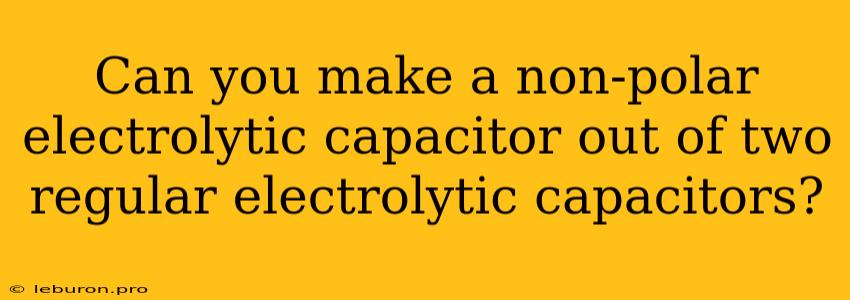Can you make a non-polar electrolytic capacitor out of two regular electrolytic capacitors? This is a question that often arises in the minds of electronics enthusiasts, especially when dealing with circuits that require non-polar capacitors, but only have standard electrolytic capacitors available. While it's tempting to think that simply connecting two electrolytic capacitors in a specific way will achieve this, the reality is that this approach is not recommended and poses several technical challenges.
Understanding Polarity in Electrolytic Capacitors
Electrolytic capacitors, unlike ceramic or film capacitors, have a defined polarity. This means they have a positive and a negative terminal, and connecting them incorrectly can lead to damage or even explosions. This polarity is due to the internal structure of the capacitor, where a thin oxide layer acts as the dielectric. This oxide layer forms during the manufacturing process and is specifically tailored for a positive voltage on the positive terminal.
How Polarity Impacts Performance
When a positive voltage is applied to the positive terminal, the oxide layer acts as an insulator, allowing the capacitor to store charge. However, if the voltage is reversed, the oxide layer breaks down, potentially causing irreversible damage to the capacitor. In some cases, this breakdown can lead to a sudden release of energy, which manifests as an explosion.
The Challenge of Making a Non-Polar Capacitor
While it's possible to connect two electrolytic capacitors back-to-back to create a non-polar configuration, this method has several drawbacks:
1. Voltage Limitations:
Connecting two electrolytic capacitors back-to-back halves the voltage rating of the resulting non-polar configuration. This is because the voltage is split across both capacitors.
2. Increased Equivalent Series Resistance (ESR):
Each electrolytic capacitor inherently has some resistance. Connecting them back-to-back effectively doubles this resistance, leading to higher energy losses and potentially affecting circuit performance.
3. Reduced Capacitance:
The resulting non-polar capacitor will have a lower capacitance than the individual capacitors. This is because the capacitance values are effectively in series, resulting in a reduced total capacitance.
4. Stability Issues:
The back-to-back configuration might lead to stability issues. As the voltage changes across the circuit, the individual capacitors may react differently, leading to unpredictable behavior.
5. Potential for Damage:
Even with a back-to-back configuration, the risk of damage to the capacitors remains. The reversed voltage could still cause damage, especially if the circuit experiences voltage spikes or transients.
Alternatives to Non-Polar Electrolytic Capacitors
Instead of trying to create a non-polar capacitor using two electrolytic capacitors, consider these alternatives:
1. Non-Polar Electrolytic Capacitors:
These capacitors are specifically designed for applications requiring non-polar operation. They typically use a different construction method that eliminates the need for a specific polarity.
2. Ceramic Capacitors:
Ceramic capacitors are often available in non-polar versions and offer excellent performance in many applications. They typically have lower ESR than electrolytic capacitors, making them suitable for high-frequency circuits.
3. Film Capacitors:
Film capacitors are another option for non-polar applications. They offer high voltage ratings and low ESR, making them suitable for demanding circuits.
Conclusion
While the idea of creating a non-polar capacitor out of two electrolytic capacitors might seem like a convenient solution, it is not recommended due to the limitations and risks involved. The resulting configuration will have a lower voltage rating, higher ESR, and lower capacitance, potentially affecting circuit performance. It's crucial to prioritize safety and choose appropriate non-polar capacitors designed for the specific application to ensure reliable and stable operation of your electronic circuits.
